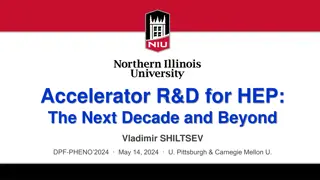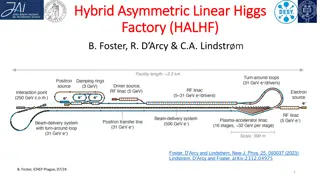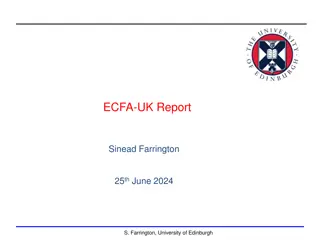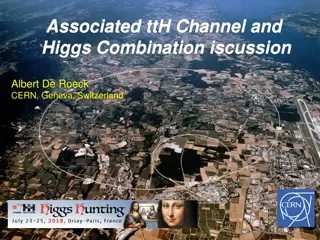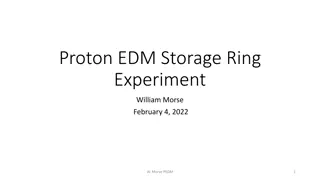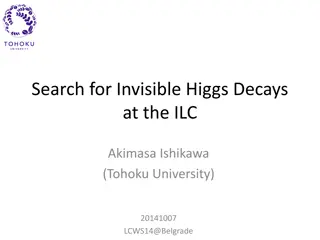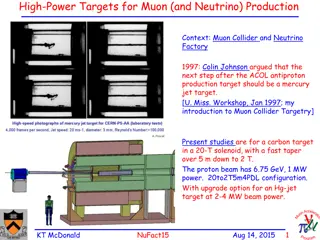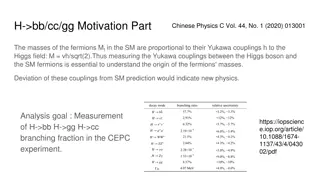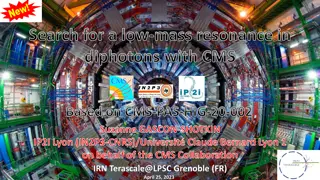
Analyzing Particle Kinematics in SiD for Kaon Identification
Explore the identification of kaons using time-of-flight data in SiD, comparing momentum spectra, and analyzing decay products in simulated environments. Discover the differentiation between pions and kaons through jet composition analysis.
Download Presentation

Please find below an Image/Link to download the presentation.
The content on the website is provided AS IS for your information and personal use only. It may not be sold, licensed, or shared on other websites without obtaining consent from the author. If you encounter any issues during the download, it is possible that the publisher has removed the file from their server.
You are allowed to download the files provided on this website for personal or commercial use, subject to the condition that they are used lawfully. All files are the property of their respective owners.
The content on the website is provided AS IS for your information and personal use only. It may not be sold, licensed, or shared on other websites without obtaining consent from the author.
E N D
Presentation Transcript
Time of Flight in SiD By Alexander Albert, Jan Strube, and Chester Mantel
The Search for Kaons Via Time of Flight First, the entire momentum spectrum of the quarks should be explored in a MC particle simulated environment, and then compared with the detector level data Provides cross-check that detector simulation works Compute from jet finding algorithms as well Explore low momentum particles from these jets: find strange kaons Use Time of Flight (TOF) to ID particles as kaons or pions - presence of kaons in a jet suggests occurence of Higgs to Strange decay
Kinematic Properties of Strange Jets (MC Particles) Can the momentum spectrum of the quarks and decay products be ascertained in a purely analytical way? Does the data we collect from jets particles match our predictions? If we assume and , then the Higgs and Z-bosons must have the same magnitude of momentum in opposite directions. From (in natural units) which leads to momentum of the Higgs and Z bosons can be deduced (~ 63 GeV) Can apply similar analysis to find limits of decay quark momentum (let s assume quarks are massless) - the limits are given by the case in which one quark moves parallel to the Higgs, and the other antiparallel , the Limits of quark momentum are ~38 GeV and ~101 GeV
MC Particle MC Particle
Pions vs Kaons Differentiation for Low Energy Tracks As discussed by Chester, the key to understanding the Higgs to Strange coupling is through an analysis of jet composition Almost all reco particles are identified as pions; how many are actually kaons, which we would expect from a strange decay chain? The most easily recognizable difference between the two is the mass K ~ 493.677 MeV/c2 For a given momentum, each particle should have a different required time of flight to reach the detector Data collected from both barrel and end caps, ensured one-to-one relationship Goal: cut all particles with a less than 50% Kaon likelihood rate ~ 139.57018 MeV/c2
Time of Flight (ns)
Exploring 2D Histograms Developed 2D histograms for both kaons and pions separately Each cell gives the proportion of pions/kaons that have the specified Momentum and TOF (L_pi and L_K) Assumed a 0.05 GeV Momentum binning and a 50 ps time binning Determined the likelihood a given particle is a kaon or a pion by comparing relative probabilities pi_likelihood = L_pi / (L_pi+L_K) K_likelihood = L_K / (L_pi+L_K) Despite tuning parameters and bin resolution, not nearly enough data for significant statistics
Momentum vs TOF function Due to shortcomings of the 2D histogram approach, I developed a function to determine the TOF as a function of Momentum Outputs two different values, one if particle is a kaon, one if it is a pion Fit a Gaussian of width 1 ns, centered at the calculated value, and determined the value of the function at the measured TOF Determined pion vs kaon likelihood by comparing relative probabilities (like 2D histogram) Developed two separate functions, one for particles that hit the barrel, other for end cap End cap function relatively trivial, , where h is given by distance from vertex to endcap (supplied by engineering schematic) and v is z-component of the velocity
Geometry of the Barrel Function All values for momentum, velocity, and arc length are projected onto the xy plane S represents the path taken by the particle, where R is the radius of curvature, and a is the radius of the barrel Since s = R , and /2 = , s = . The radius of curvature of the particle is given by P/(qB) The arc length is divided by the transverse component of the velocity to give TOF From https://mathworld.wolfram.com/CircularSegment.html
Costheta cut: 1657/sqrt(1657^2+1265^2) From https://confluence.slac.stanford.edu/display/SiD/SID+Engineering?preview=/170767215/213904747/ SiDparJuly2016.pdf
Percent of Kaons with a Kaon Likelihood above 0.5: 23% Percent of Pions with a Kaon Likelihood above 0.5: 6.48%
Concluding Remarks Confident in effectiveness of reconstructing particles by detector simulation Verified by jet momentum analysis comparison between MC Particle and Reco tracks We were able to reconstruct the time of flight from the interaction point to the timing layer Though simulation provides consistently larger times than constructed function We were able to determine particle ID from a given momentum and TOF Possible Future Work: Debug function and explore other differentiation techniques




